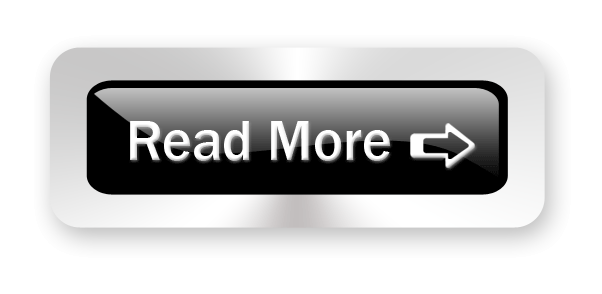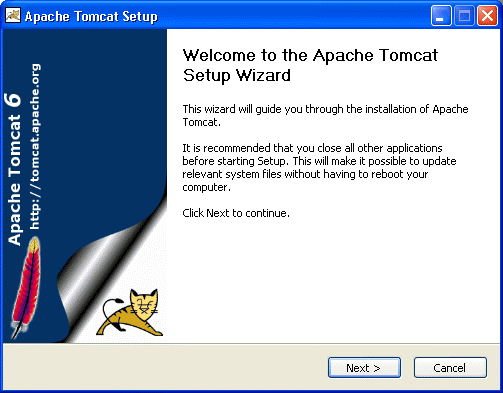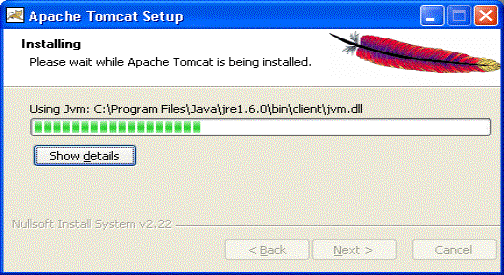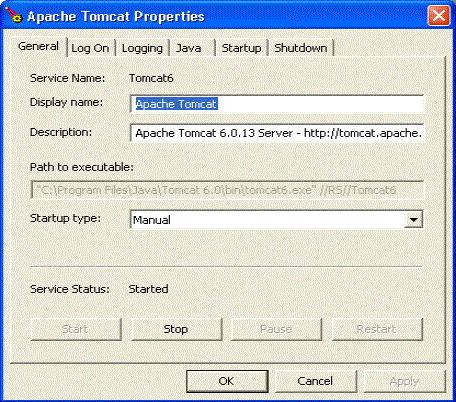Introduction to Hibernate
12/14/10Posted by
Fulto
0 Comments
we can use the techlologies like JDO( Java Data Object) , Hibernate , toplink etc for accessing the databases.
All these technologies internally uses JDBC API.
A developer can save lot of time during the development by using Hibernate/JDO/TOPLINK etc.. instead of directly making use of JDBC API.
Hibernate called as Object Relational Mapping Technologies (ORM Technologies).
The data that is stored in the database tables managed by the RDBMS Servers is called as "Realtional Data".
To use Hibernate we must provide the files called as "hbm" files (Hibernate Mapping Files).In that "hbm" files we must provide the following details.
1) The mapping between the database table and the java class.
2) The mapping between the columns of a database table and the properties of the java class that is mapped to the table.
All these technologies internally uses JDBC API.
A developer can save lot of time during the development by using Hibernate/JDO/TOPLINK etc.. instead of directly making use of JDBC API.
Hibernate called as Object Relational Mapping Technologies (ORM Technologies).
The data that is stored in the database tables managed by the RDBMS Servers is called as "Realtional Data".
To use Hibernate we must provide the files called as "hbm" files (Hibernate Mapping Files).In that "hbm" files we must provide the following details.
1) The mapping between the database table and the java class.
2) The mapping between the columns of a database table and the properties of the java class that is mapped to the table.
package org.myfulto;
public class Employee
{
private Long empNo;
private String empName;
private String address;
private Float salary;
// setters and getters supporting the follwoing properties
//empNo, empName, salary and address.
public void setEmpNo(Long empno)
{
this.empNo=empno;
}
public String getEmpNo()
{
return this.empNo;
}
public void setEmpName(String empName)
{
this.empName=empName;
}
public String getEmpName()
{
return this.empName;
}
public void setaddress(String addr)
{
this.address=addr;
}
}

Labels:
HIBERNATE
usefule site for registering new software company in India
Posted by
Fulto
http://kumaran.wordpress.com/2006/09/06/procedure-involved-to-start-a-company-private-limited-in-india/

Useful sites for Java Based MiniProjects and aminProjects
Posted by
Fulto
The following are the very useful sites for downloading JAVA BASED MINI PROJECTS AND MAIN PROJECTS.
http://mindprod.com/project/projects.html
http://1000projects.com/
http://mindprod.com/project/projects.html
http://1000projects.com/

Labels:
JAVA MAIN PROJECTS,
JAVA MINI PROJECTS
Introduction to Struts Framework
12/3/10Posted by
Fulto
Struts Framework is collection of utility classes for doing integrating logic.
It provides readymade classes for avoiding manual work while developing huge web applications.
Struts framework was developed by Apache Software Foundation.
It provides readymade classes for avoiding manual work while developing huge web applications.
Struts framework was developed by Apache Software Foundation.

Labels:
STURTS
What is the use of DAO( Data Access Object)
Posted by
Fulto
DAO pattern is uesd for connecting with the backend softwares like DBMS and FILE SYSTEMS.
The follwoing are the Sample code for creating DAO.
<pre class="java" name="code">
public interface EmpDAO
{
void createEmp();
Employee getEmpByID(int id);
List getEmpsByDepartment(int did);
}
</pre>
We need to implement the above interface(EmpDAO).
The follwoing is the implementation class for Oracle Data Base.
<pre class="java" name="code">
public class ImpOracleEmp implemnets EmpDAO
{
/* write the code for implementing methods that are specific to Oracle Data Base */
}
</pre>
The follwoing is the implementation class for XML.
<pre class="java" name="code">
public class ImpXMLEmp implemnets EmpDAO
{
/* write the code for implementing methods that are specific to XML*/
}
</pre>
The follwoing are the Sample code for creating DAO.
<pre class="java" name="code">
public interface EmpDAO
{
void createEmp();
Employee getEmpByID(int id);
List getEmpsByDepartment(int did);
}
</pre>
We need to implement the above interface(EmpDAO).
The follwoing is the implementation class for Oracle Data Base.
<pre class="java" name="code">
public class ImpOracleEmp implemnets EmpDAO
{
/* write the code for implementing methods that are specific to Oracle Data Base */
}
</pre>
The follwoing is the implementation class for XML.
<pre class="java" name="code">
public class ImpXMLEmp implemnets EmpDAO
{
/* write the code for implementing methods that are specific to XML*/
}
</pre>

Labels:
STURTS
Flow of Model View Controller architecture
12/2/10Posted by
Fulto
MVC Architecture provides the easiness for developing web applications by separating business logic and display logic.
MVC architecture have main three components that are
1) Model
2) View
3) Controller
Model: Model component specifies the business logic and data of web applications.
Business logic includes storing, updating of data into relational databases.
View:
View Component represents the display logic of output which will sent to the client.
In this view developer never worried about the business logic.
Controller: Controller Component specifies the flow of requests of applications.
The following figure shows the communications between model, view and controller components.
The following are the steps in the above figure:
- A browser request is submitted to and handled by the Action Servlet class, which has one physical instance per server.
- The Action Servlet calls the Request Processor to prepare the request and response objects, determine action mapping etc.
- The Request Processor creates (or re-uses) the corresponding Action Form bean, populates it with the input fields from the html form and invokes form validation (if required).
- Using the action mapping in its config file, the Request Processor passes control to the appropriate Action Class. The Struts framework pools instances of Action classes; therefore, if the action has already been requested, it will be retrieved from the instance pool, as opposed to being created with every request. However, without multi-threading, this can lead to significant collisions when multiple users are accessing the same action.
- The Action Class invokes business logic beans and passes the Action Form (or a portion of it) to the model. The model may be EJB-based, or consist of plain Java objects.
- After the action completes execution, it is returned as an Action Forward object which determines the target of the request.
- Control is finally returned to the Request Processor, which forwards the request to the appropriate target.
- The JSP page may get data from the Model through a set of tag libraries.

Labels:
MVC Architectechture,
STURTS
What is the use of Design Patterns in The Designing of Sttruts Aplications?
Posted by
Fulto
To develop complicated applications we can use Struts frame work of Apache.
M-V-C II architecture is used in Struts applications.
To develop Struts based applications we need know about the Design patterns.
Definition of Design Patterns:
Design pattern is a tree-part rule for express a relation between a certain context, a problem and a solution.
The following are useful design patterns in the designing of Struts based web applications.
1) Front Controller Design Patterns
2) Application Controller
3) Data Access object (DAO)
4) Data Transaction Object (DTO)

Labels:
STURTS
Introductio To EJB
11/17/10Posted by
Fulto
EJB stands for Enterprise Java Beans.
EJB is a reusable component for local, remote or both clients.
EJB provides high security for webapplications.
Any client can interact with the bean through the Bean Container only.
Bean Container can recive the request of clients , process the client requestrs and send the response to the appropriate client.
There are three types of Enterprise Java Beans.
That are 1) session Beans
2)Entity Beans
3) Message Drivne Beans
EJB is a reusable component for local, remote or both clients.
EJB provides high security for webapplications.
Any client can interact with the bean through the Bean Container only.
Bean Container can recive the request of clients , process the client requestrs and send the response to the appropriate client.
There are three types of Enterprise Java Beans.
That are 1) session Beans
2)Entity Beans
3) Message Drivne Beans

Labels:
EJB Notes
Notes On Servlet API or Explain about the servlet packages
11/12/10Posted by
Fulto
Servlet API contains the following 2 paclages.
1. java.servlet
2. java.servlet.http
Package java.servlet
This package contains the following list of classes and interfaces
Interfaces
Classes
This package contains the following list of interfaces and classes
Interfaces
Classes
1. java.servlet
2. java.servlet.http
Package java.servlet
This package contains the following list of classes and interfaces
Interfaces
- RequestDispatcher
- Servlet
- ServletConfig
- ServletContext
- ServletRequest
- ServletResponse
- SingleThreadModel
Classes
- GenericServlet
- ServletException
- ServletInputStream
- ServletOutputStream
- UnavailableException
This package contains the following list of interfaces and classes
Interfaces
- HttpServletRequest
- HttpServletResponse
- HttpSession
- HttpSessionBindingListener
- HttpSessionContext
Classes
- Cookie
- HttpServlet
- HttpSessionBindingEvent
- HttpUtils

Labels:
SERVLETS
How to Install Tomcat Webserver
11/10/10Posted by
Fulto
In this section we will show the process to downloading and installing Tomcat 6 on your computer system. The steps of downloading and installing are easy and you can learn the process very fast. First of all learn the steps of 'How to download Apache Tomcat server on your computer'. Click the link: http://tomcat.apache.org/download-60.cgi and follow the steps according to your requirement to achieve Tomcat server.
Step 1: Installation of JDK:Before beginning the process of installing Tomcat on your system, ensure first the availability of JDK on your system program directory. Install it on your system if not already installed (because any version of tomcat requires the Java 1.6 or higher versions) and then set the class path (environment variable) of JDK. To set the JAVA_HOME Variable: you need to specify the location of the java run time environment to support the Tomcat else Tomcat server can not run.
This variable contains the path of JDK installation directory.
| set JAVA_HOME=C:\Program Files\Java\jdk1.6 |
Note: it should not contain the path up to bin folder. Here, we have taken the URL path according to our installation convention.
For Windows OS, go through the following steps:
| Start menu->Control Panel->System->Advanced tab->Environment Variables->New->set the Variable name = JAVA_HOME and variable value = C:\Program Files\Java\jdk1.6 |
Now click on all the subsequent ok buttons one by one. It will set the JDK path.
Step 2:
For setting the class path variable for JDK, do like this:
| Start menu->Control Panel->System->Advanced tab->Environment Variables->New-> Set PATH="C:\Program Files\Java\jdk1.6\bin"; %PATH% |
OR
First, right click on the
| My Computer->properties->advance->Environment Variables->path. |
Now, set bin directory path of JDK in the path variable
Step 3:
The process of installing Tomcat 6.0 begins here from now. It takes various steps for installing and configuring the Tomcat 6.0.

A Welcome screen shot appears that shows the beginning of installation process. Just click on the 'Next' button to proceed the installation process.
Steps 4:
A screen of 'License Agreement' displays.
Click on the 'I Agree' button.
Step 5:
A screen shot appears asking for the 'installing location'
Choose the default components and click on the 'Next' button.
Step 6:
A screen shot of 'Configuration Options' displays on the screen. Choose the location for the Tomcat files as per your convenience. You can also opt the default Location
Go to the specified location as " Tomcat 6.0 \conf \server.xml ". Within the server.xml file choose "Connector" tag and change the port number.
Now, click on the 'Next' button to further proceed the installation process.
Step 7:
A Window of Java Virtual Machine displays on the screen
This window asks for the location of the installed Java Virtual Machine. Browse the location of the JRE folder and click on the Install button. This will install the Apache tomcat at the specified location.
Step 8:
A processing window of installing displays on the screen.

To get the information about installer click on the "Show details" button
Step 9:
A screen shot of 'Tomcat Completion' displays on the screen.
Click on the 'Finish' button.
Step 10:
A window of Apache Service Manager appears with displaying the running process.
Let the running process goes on.
Step 11:
After completing the installation process, the Apache Tomcat Manager appears on the toolbar panel like shown in the below picture.
Configuring Tomcat Manager
To Configure the Tomcat Manager, there are two ways; either user can configure Tomcat directly from the toolbar panel or can configure it from Control Panel Section.i-) Configuring from toolbar Panel
To Configure Apache Tomcat web server from the toolbar panel, you have to press 'double click' on the appeared icon
A configured window appears on the desktop. Now, just click on the Startup button. The installation process will be completed.
ii-) Configuration from the Control Panel
To configure the Apache Tomcat Manager, Users will have to follow the follwing steps:
Click on the Start up button -- select Control Panel -- Administrator Tool -- Services -- select Apache Tomcat.
The following screen displays on the monitor.
Double click on the Apache Tomcat. The window of Apache Tomcat Properties appears on the screen.
Now, Click on the start up button. The Apache Tomcat is now ready to function.
To operate it, follow the below steps of processing.
Start the Tomcat Server:
1.Start the tomcat server from the bin folder of Tomcat 6.0 directory by double clicking the "tomcat6.exe" file.
OR create a shortcut of this .exe file at your desktop.
2. Now Open web browser and type URL http://localhost:8080 in the address bar to test the server
3. To Stop the Tomcat Server: Stop the server by pressing the "Ctrl + c" keys.
The screen of Apache Tomcat software looks like this:

Labels:
JSP TUTORIALS,
SERVLETS
Free Download of Tomcat Web Server
Posted by
Fulto
acd
11/9/10Posted by
Fulto
ajsdgfuiasydtgf ausydtgf oayustd foatdsf uiapstdf otds fouiastdf otdsf oaisd
1. Describe Virtual memory.
2. Describe cache memory.
3. Explain memory hierarchy in detail.
4. Explain how to reduce cache misses penalty and miss rate.
5. Describe symmetric shared memory architecture
6. Write notes on Multiprocessors and thread level parallelism
7. Write notes on multi threading.
8. Write notes on distributed shared memory.
9. Explain how to design an I/O system.
10. Describe RAID.
11. Explain about storage systems.
12 a] Describe data flow design alternatives.
b] Explain the organization of EDDY data flow machine.
13. Describe interconnection network media.
14. Explain how to inter connect the networks.
15 Explain how to design a cluster.
16 Write notes on inter connection networks and clusters.
1. Describe Virtual memory.
2. Describe cache memory.
3. Explain memory hierarchy in detail.
4. Explain how to reduce cache misses penalty and miss rate.
5. Describe symmetric shared memory architecture
6. Write notes on Multiprocessors and thread level parallelism
7. Write notes on multi threading.
8. Write notes on distributed shared memory.
9. Explain how to design an I/O system.
10. Describe RAID.
11. Explain about storage systems.
12 a] Describe data flow design alternatives.
b] Explain the organization of EDDY data flow machine.
13. Describe interconnection network media.
14. Explain how to inter connect the networks.
15 Explain how to design a cluster.
16 Write notes on inter connection networks and clusters.

Computer Organization Question bank for III ECE (unit-V, VI, VII, VII)
11/2/10Posted by
Fulto
Labels:
Computer Organization Notes
How to give Colors to the Text in HTML File?
10/29/10Posted by
Fulto
HTML is a very useful programing language for developing webpages with colorful text.
The following are the steps for giving color to the text of webpages in HTML Program.
The following are the steps for giving color to the text of webpages in HTML Program.

Labels:
HTML NOTES
How to create First HTML Program?
Posted by
Fulto
The following are the steps for creating simple html program in Windows operating system.
Step 1: Open notepad
Step 2: Save the file with file extention ".html" or ".htm" for example "aboutme.html" or "aboutme.htm" in your working folder.( e:/html_programs/aboutme.html)
Step 3: Write the following code in the above created notepad file.
<html>
<head>
<title>First HTML Program for displaying MY Details</title>
</head>
<body>
Name: E. Jaya Kumar Reddy<br>
Qualification : M.Tech<br>
Favourite Subjects: JAVA, DBMS
</body>
</html>
Step 4: Save the above code
Step 5: Goto the location where u have saved your aboutme.html program and then double click on the file then the following out put will be displayed.
Step 1: Open notepad
Step 2: Save the file with file extention ".html" or ".htm" for example "aboutme.html" or "aboutme.htm" in your working folder.( e:/html_programs/aboutme.html)
Step 3: Write the following code in the above created notepad file.
<html>
<head>
<title>First HTML Program for displaying MY Details</title>
</head>
<body>
Name: E. Jaya Kumar Reddy<br>
Qualification : M.Tech<br>
Favourite Subjects: JAVA, DBMS
</body>
</html>
Step 4: Save the above code
Step 5: Goto the location where u have saved your aboutme.html program and then double click on the file then the following out put will be displayed.
Ask me about your dought by posting question as a Comment?

Labels:
HTML NOTES
Disclaimer
Posted by
Fulto
This is the team of Kalcode Techno Team which provide the online material for java proffesionals. The information available in this site is prepared by the specialists of java technology.

FORMAL LANGUAGES AND AUTOMATA THEORY Prefinal Question papers for III IT
10/26/10Posted by
Fulto
Set No. 1
FORMAL LANGUAGES AND AUTOMATA THEORY
B.Tech III -I Semester (Information Technology)
Time: 3 hours Max Marks: 80
Answer any FIVE Questions
All Questions carry equal marks

Labels:
DDB
Human Computer interaction Prefinla Question paper
Posted by
Fulto
Set No. 1
HUMAN COMPUTER INTERACTION
B.Tech IV-I Semester (Information Technology)
Time: 3 hours Max Marks:80
Answer any FIVE Questions
All Questions carry equal marks

Labels:
HCI
What is mean by servlets? (or) Deffinition of servlets?
Posted by
Fulto
Servlet is a java class which runs in the server side.
Servlet is a pure java class to handle client requests, for example we know that in the login page of websites generally we need to enter USER NAME and PASSWORD , then if the given details are correct then inbox page will be displayed , if given details are wrong then it displays an error page.
Do you know how that is possible?
Servlet is a pure java class to handle client requests, for example we know that in the login page of websites generally we need to enter USER NAME and PASSWORD , then if the given details are correct then inbox page will be displayed , if given details are wrong then it displays an error page.
Do you know how that is possible?

Labels:
SERVLETS
Web tech nology
Posted by
Fulto
The term Web 2.0 is commonly associated with web applications that facilitate interactive information sharing, interoperability, user-centered design,[1] and collaboration on the World Wide Web. A Web 2.0 site gives its users the free choice to interact or collaborate with each other in a social media dialogue as creators (prosumer) of user-generated content in a virtual community, in contrast to websites where users (consumer) are limited to the passive viewing of content that was created for them. Examples of Web 2.0 include social-networking sites, blogs, wikis, video-sharing sites, hosted services, web applications, mashups and folksonomies.
The term is closely associated with Tim O'Reilly because of the O'Reilly Media Web 2.0 conference in 2004.[2][3] Although the term suggests a new version of the World Wide Web, it does not refer to an update to any technical specifications, but rather to cumulative changes in the ways software developers and end-users use the Web. Whether Web 2.0 is qualitatively different from prior web technologies has been challenged by World Wide Web inventor Tim Berners-Lee, who called the term a "piece of jargon"[4], precisely because he intended the Web in his vision as "a collaborative medium, a place where we [could] all meet and read and write". He called it the 'Read/Write Web'.[5]
The term is closely associated with Tim O'Reilly because of the O'Reilly Media Web 2.0 conference in 2004.[2][3] Although the term suggests a new version of the World Wide Web, it does not refer to an update to any technical specifications, but rather to cumulative changes in the ways software developers and end-users use the Web. Whether Web 2.0 is qualitatively different from prior web technologies has been challenged by World Wide Web inventor Tim Berners-Lee, who called the term a "piece of jargon"[4], precisely because he intended the Web in his vision as "a collaborative medium, a place where we [could] all meet and read and write". He called it the 'Read/Write Web'.[5]

Subscribe to:
Posts (Atom)






























